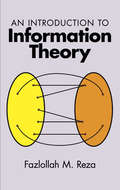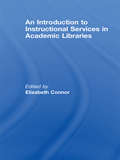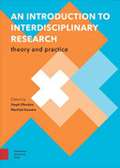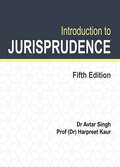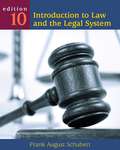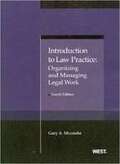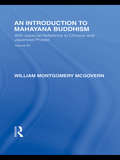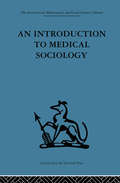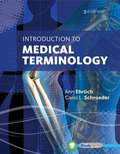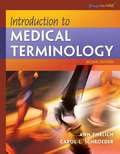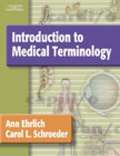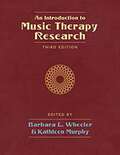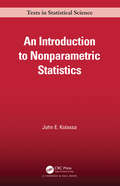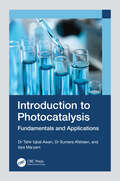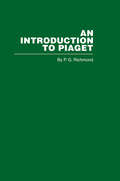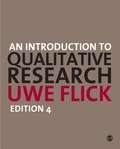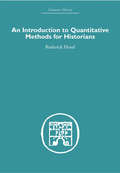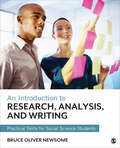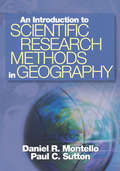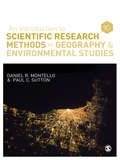- Table View
- List View
An Introduction to Information Theory (Dover Books on Mathematics)
by Fazlollah M. RezaWritten for an engineering audience, this book has a threefold purpose: (1) to present elements of modern probability theory — discrete, continuous, and stochastic; (2) to present elements of information theory with emphasis on its basic roots in probability theory; and (3) to present elements of coding theory.The emphasis throughout the book is on such basic concepts as sets, the probability measure associated with sets, sample space, random variables, information measure, and capacity. These concepts proceed from set theory to probability theory and then to information and coding theories. No formal prerequisites are required other than the usual undergraduate mathematics included in an engineering or science program. However, since these programs may not include a course in probability, the author presents an introductory treatment of probability for those who wish to pursue the general study of statistical theory of communications. The book is divided into four parts: memoryless discrete themes, memoryless continuum, schemes with memory, and an outline of some recent developments. An appendix contains notes to help familiarize the reader with the literature in the field, while the inclusion of many reference tables and an extensive bibliography with some 200 entries makes this an excellent resource for any student in the field.
An Introduction to Instructional Services in Academic Libraries
by Elizabeth ConnorMore than ever before, librarians are being called upon to contribute considerable energy, knowledge, and leadership to fostering the academic success of students through information literacy. Unique in its expansive breadth and in-depth approach, An Introduction to Instructional Services in Academic Libraries explores the latest methods and ideas for planning, delivering, and evaluating effective instructional sessions. Providing librarians with informative, real-world case studies culled from over three dozen prominent librarian-instructors from across the US and Canada, An Introduction to Instructional Services in Academic Libraries comprehensively covers the topics of experiential learning, hybrid models of library instruction, interdisciplinary inquiry through collaboration, introducing primary documents to undergrads, using case studies in credit-bearing library courses, teaching information literacy to ESL students, information literature for the non-traditional student, preparing an advanced curriculum for graduate students, librarians in the online classroom, and teaching distance education students. An Introduction to Instructional Services in Academic Libraries features numerous planning documents, survey instruments, handouts, active learning exercises, and extensive references which make it an ideal resource for educators and librarians everywhere.
An Introduction To Interdisciplinary Research
by Machiel Keestra Steph B. J. MenkenOne of the major areas of emphasis in the academy in recent years has been interdisciplinary research, a trend that promises new insights and innovations rooted in cross-disciplinary collaboration. This book is designed to help students understand the tools required for stepping beyond traditional disciplinary boundaries and applying knowledge and insights from multiple fields. Relentlessly focused on practical applications, the book will enable students to plan and execute their own interdisciplinary research projects.
Introduction To Jurisprudence
by Dr Avtar Singh Dr Harpeet Kaur"Introduction to Jurisprudence" by Dr. Avtar Singh and Dr. Harpeet Kaur provides a comprehensive exploration of the fundamental concepts and theories that underpin the field of jurisprudence. The book delves into the nature of law, examining its historical evolution and the diverse philosophical perspectives that have shaped legal thought. It navigates through key jurisprudential themes such as justice, rights, and the relationship between law and morality. The authors offer a nuanced understanding of legal theories, including positivism, natural law, legal realism, and feminist jurisprudence. With clarity and depth, the book engages readers in critical reflection on the nature of law and its impact on society. It serves as an invaluable resource for students, scholars, and practitioners seeking a robust foundation in jurisprudential studies.
Introduction to Labour and Industrial Laws
by Dr Avtar Singh Prof Dr Harpreet KaurIntroduction to Labour and Industrial Laws by Avtar Singh offers a comprehensive overview of key principles governing employment and industrial relations in India. The book covers major labour legislations, including laws on wages, working conditions, social security, and trade unions. It explains the evolution and objectives of labour laws in a clear, accessible manner. Special focus is given to the rights and duties of employers and employees within the legal framework. Ideal for law students and professionals, it bridges theoretical understanding with practical application.
Introduction to Law and the Legal System 10th Edition
by Frank August SchubertThis text is a survey of the American legal system and can be used in a variety of courses such as Survey of Law, Introduction to Law and the Legal System, Law and Society, Legal Environment and Business, and Legal Process.
Introduction to Law Practice: Organizing and Managing Legal Work
by Gary A. MunnekeThis casebook introduces practice management skills in a variety of areas, including formation of a firm, development of a marketing plan, hiring and retaining staff, setting up a law office, leveraging the lawyer's intellectual work product, marshalling IT resources, establishing office systems, setting and collecting fees, and managing a budget. The new edition features an entirely new first section called "The Business of Law" which focuses on the economics of the profession and looks at the changing business model of law firms and billing practices. This edition also has new sections focusing on creating "practice-ready" lawyers
An Introduction to Mahāyāna Buddhism: With especial Reference to Chinese and Japanese Phases (Routledge Library Editions: Japan)
by William M McGovernWilliam Montgomery McGovern’s Introduction to Mahayana Buddhism was one of the first books on Mahayana Buddhism written for a Western audience. It predates influential English language overviews of Buddhism by D. T. Suzuki, A. Watts, and W. Rahula. The author was born in New York City in 1897 and spent his latter teenage years (1914-1917) training at the Nishi Hongwanji Mahayana Buddhist monastery in Kyoto, Japan. He founded the Mahayana Association at age eighteen and edited and published the journal "Mahayanist" while completing his studies at the monastery. Introduction to Mahayana Buddhism was written as part of a thesis which secured him his Buddhist degree and an honorary ordination as a Buddhist priest. Intended as a simplified and introductory text for a lay audience, the book reflects the unique perspective of a Westerner trained in Japan at a time when Mahayana Buddhism was little known in the West. Referencing Buddhist literature, it gives a short history of Buddhism and the divergence of schools of Buddhist philosophy, introduces the four noble truths, the philosophy of Karma, the nature of Buddhahood, reincarnation and the road to nirvana, Buddhist cosmology, and psychological and philosophical elements of Buddhist teachings. Although the divisions of non Mahayana Buddhist sects and philosophy described may be considered dated, Introduction to Mahayana Buddhism remains significant for its historical value in presenting Eastern religious and philosophical thought to Westerners at a pivotal time in history.
An Introduction to Medical Sociology (Social Science Paperbacks Ser.)
by David TuckettTavistock Press was established as a co-operative venture between the Tavistock Institute and Routledge & Kegan Paul (RKP) in the 1950s to produce a series of major contributions across the social sciences. This volume is part of a 2001 reissue of a selection of those important works which have since gone out of print, or are difficult to locate. Published by Routledge, 112 volumes in total are being brought together under the name The International Behavioural and Social Sciences Library: Classics from the Tavistock Press. Reproduced here in facsimile, this volume was originally published in 1976 and is available individually. The collection is also available in a number of themed mini-sets of between 5 and 13 volumes, or as a complete collection.
Introduction to Medical Terminology
by Ann Ehrlich Carol L. SchroederDesigned for the beginning health care student, INTRODUCTION TO MEDICAL TERMINOLOGY 3E simplifies the process of learning hundreds of complex medical terms. The See and Say pronunciation system makes pronouncing unfamiliar terms easy. Because word parts are integral to learning medical terminology, mastery of these "building blocks" is emphasized in every chapter. Organized by body system, chapters begin with an overview of the structures and functions of that system so you can relate these to the specialties, pathology, diagnostic, and treatment procedures that follow. A workbook offers word part and comprehensive medical terminology reviews, flashcards, and learning exercises in a variety of formats that require written answers.
Introduction to Medical Terminology
by Ann Ehrlich Carol L. SchroederDesigned for the beginning health care student, Introduction to Medical Terminology, Second Edition, simplifies the process of learning hundreds of complex medical terms. The See and Say pronunciation system makes pronouncing unfamiliar terms easy. Because word parts are integral to learning medical terminology, mastery of these "building blocks" is emphasized in every chapter. Organized by body system, chapters begin with an overview of the structures and functions of that system so you can relate these to the specialties, pathology, diagnostic, and treatment procedures that follow. A workbook offers word part and comprehensive medical terminology reviews, flashcards, and learning exercises in a variety of formats that require written answers.
Introduction To Medical Terminology
by Ann Roe-Hafer Carol L. Schroeder Ann EhrlichThis undergraduate textbook describes the structure and function of the 12 systems that make up the human body, defines each system's pathology, and overviews the primary diagnostic and treatment procedures performed. Color illustrations are provided. The CD- ROM contains exercises and games. Annotation (c)2003 Book News, Inc. , Portland, OR (booknews. com)
An Introduction to Music Therapy Research
by Barbara L. WheelerAn introductory overview of how research has been conceived and implemented in music therapy over the last several decades. The book was designed for those who are beginning their studies in music therapy research, and it is especially well-suited for use as an accompaniment to classroom instruction. <P><P> Seventeen of the chapters were excerpted from Music Therapy Research (3rd Edition), a much larger volume of 68 chapters that gives considerable detail on numerous topics and sub-topics. In addition, three chapters (15, 16, 17) were specially written to provide a birds-eye view of some of the chapters that were not included, and in particular, those chapters in the larger book that examined the numerous methodological designs and approaches used in objectivist, interpretivist and other types of music therapy research.
An Introduction to Nonparametric Statistics (Chapman & Hall/CRC Texts in Statistical Science)
by John E. KolassaAn Introduction to Nonparametric Statistics presents techniques for statistical analysis in the absence of strong assumptions about the distributions generating the data. Rank-based and resampling techniques are heavily represented, but robust techniques are considered as well. These techniques include one-sample testing and estimation, multi-sample testing and estimation, and regression. Attention is paid to the intellectual development of the field, with a thorough review of bibliographical references. Computational tools, in R and SAS, are developed and illustrated via examples. Exercises designed to reinforce examples are included. Features Rank-based techniques including sign, Kruskal-Wallis, Friedman, Mann-Whitney and Wilcoxon tests are presented Tests are inverted to produce estimates and confidence intervals Multivariate tests are explored Techniques reflecting the dependence of a response variable on explanatory variables are presented Density estimation is explored The bootstrap and jackknife are discussed This text is intended for a graduate student in applied statistics. The course is best taken after an introductory course in statistical methodology, elementary probability, and regression. Mathematical prerequisites include calculus through multivariate differentiation and integration, and, ideally, a course in matrix algebra.
Introduction to Photocatalysis: Fundamentals and Applications
by Tahir Iqbal Awan Sumera Afsheen Iqra MaryamExplore the intriguing world of photocatalysis with Introduction to Photocatalysis: Fundamentals and Applications. This book explores the complexities of photocatalytic processes, investigating the contributing elements, nano-photocatalyst manufacturing methodologies, and their wide applications in the energy and environmental sectors.Additionally, sophisticated modification approaches that may be used to improve the efficiency of visible light-driven processes (such as doping and plasmonics photocatalysis) are discussed. Key features include novel methodologies of photocatalysts, providing an insight on fundamentals and methodology; and examples of efficient applications of photocatalysis such as wastewater treatment, hydrogen production and CO2 reduction. Later chapters discuss the commercial aspects of photocatalysis to help guide future entrepreneurs.The book is useful for advanced undergraduates, and graduate students in a range of subjects such as physics, biotechnology, and biochemistry. This book will also prove invaluable for researchers and scientists in photocatalysis, and chemical engineers and chemists in industry R&D working on wastewater treatment and renewable sources of energy. It stands out as a modernized version of current literature that bridges the gap between scholars and students.
Introduction to Piaget
by R.G. RichmondFirst published in 2006. Routledge is an imprint of Taylor & Francis, an informa company.
Introduction to Probability, Second Edition (Chapman & Hall/CRC Texts in Statistical Science #112)
by Joseph K. Blitzstein Jessica HwangDeveloped from celebrated Harvard statistics lectures, Introduction to Probability provides essential language and tools for understanding statistics, randomness, and uncertainty. The book explores a wide variety of applications and examples, ranging from coincidences and paradoxes to Google PageRank and Markov chain Monte Carlo (MCMC). Additional application areas explored include genetics, medicine, computer science, and information theory. The authors present the material in an accessible style and motivate concepts using real-world examples. Throughout, they use stories to uncover connections between the fundamental distributions in statistics and conditioning to reduce complicated problems to manageable pieces.The book includes many intuitive explanations, diagrams, and practice problems. Each chapter ends with a section showing how to perform relevant simulations and calculations in R, a free statistical software environment. The second edition adds many new examples, exercises, and explanations, to deepen understanding of the ideas, clarify subtle concepts, and respond to feedback from many students and readers. New supplementary online resources have been developed, including animations and interactive visualizations, and the book has been updated to dovetail with these resources. Supplementary material is available on Joseph Blitzstein’s website www. stat110.net. The supplements include:Solutions to selected exercisesAdditional practice problemsHandouts including review material and sample exams Animations and interactive visualizations created in connection with the edX online version of Stat 110.Links to lecture videos available on ITunes U and YouTube There is also a complete instructor's solutions manual available to instructors who require the book for a course.
An Introduction to Qualitative Research
by Uwe FlickA new edition of this book is available `Flick's An Introduction to Qualitative Research is quite simply the most important text on qualitative research methods in the world today. I continue to envy Flick's command of the field and its ever-expanding literature, much of which he has managed to include in his new edition' - Norman K Denzin, University of Illinois, Urbana-Champaign `Flick aims to please both the novice and the experienced researcher, and in his ambition he largely succeeds. . . . From conceptualizing the field, making sampling decisions to constructing interview guides, Flick offers practical counsel' - Science Direct `Ideal for anyone wishing to understand fully the theoretical constructs behind the qualitative research methodology' - Journal of Family Studies `The inclusion of examples, summary points and further reading is to be commended and adds to the clarity of an already clear and easy to understand text. The strength of the book lies not only in the clarity with which it is written but in the use of examples and tables. . . . I would have no problem in recommending this text equally to both pre and post-registration students of nursing, and also to students studying for higher degrees as a useable text which is easy to read and contains a vast amount of information which is logically presented' - Nurse Researcher This Third Edition of Uwe Flick's bestselling textbook has been fully revised, expanded and updated but retains all of the student-friendly elements and carefully structured qualities of the previous edition. Brand new features include: - Updated discussions and references throughout the text - The integration into all chapters of additional features including chapter overviews, case studies, lists of key points and end-of-chapter exercises - 6 new chapters including a guide to using the book, a chapter on ethics, the uses of literature in qualitative research, an overview of research design, a discussion centred on using documents, and a final chapter on qualitative online research. This new edition will ensure that An Introduction to Qualitative Research preserves its status as the essential introductory text for all students of qualitative research.
An Introduction to Quantitative Methods for Historians (Economic History Ser.)
by Roderick FloudMany statements made by historians are quantitative statements, involving the use of measurable historical evidence. The historian who uses quantitative methods to analyse and interpret such information needs to be well acquainted with the particular methods and techniques of analysis and to be able to make the best use of the data that are available. There is an increasing need for training in such methods and in the interpretation of the large volume of literature now using quantitative techniques. Dr Floud’s text, which is relevant to all branches of historical inquiry, provides a straightforward and intelligible introduction for all students and research workers. The simpler and more useful techniques of descriptive and analytical statistics are described, up to the level of simple linear regression. Historical examples are used throughout, and great attention is paid to the need to ensure that the techniques are consistent with the quality of the data and with the historical problems they are intended to solve. Attention is paid to problems of the analysis of time series, which are of particular use to historians. No previous knowledge of statistics is assumed, and the simple mathematical techniques that are used are fully and clearly explained, without the use of more mathematical knowledge than is provided by an O-level course. A bibliography is provided to guide historians towards the most useful further reading. This student friendly text was first published in 1973.
An Introduction to Research, Analysis, and Writing: Practical Skills for Social Science Students
by Bruce Oliver NewsomeThis accessible guide walks readers through the process of completing a social science research project. Written specifically to meet the needs of undergraduate research classes, it introduces students to a complete skill set, including: planning, design, analysis, argumentation, criticizing theories, building theories, modeling theories, choosing methods, gathering data, presenting evidence, and writing the final product. Students can use this text as a practical resource to navigate through each stage of the process, including choices between more advanced research techniques.
An Introduction to Research, Analysis, and Writing: Practical Skills for Social Science Students
by Bruce Oliver NewsomeThis accessible guide walks readers through the process of completing a social science research project. Written specifically to meet the needs of undergraduate research classes, it introduces students to a complete skill set, including: planning, design, analysis, argumentation, criticizing theories, building theories, modeling theories, choosing methods, gathering data, presenting evidence, and writing the final product. Students can use this text as a practical resource to navigate through each stage of the process, including choices between more advanced research techniques.
Introduction to Research Methods 5th Edition: A Practical Guide for Anyone Undertaking a Research Project
by Catherine DawsonIntroduction to Research Methods contains everything from developing an initial idea into a proposal, through to analysing data and reporting results. Whether you have to undertake a project as part of your coursework, or as part of your employment, or simply because you are fascinated by something you have observed and want to find out more, this book offers you advice on how to turn your ideas into a workable project. Specifically it will show you how to: *Choose your research methods*Choose your participants*Prepare a research proposal*Construct questionnaires*Conduct interviews and focus groups*Analyse your data*Report your findings *Be an ethical researcher
Introduction to Research Methods 5th Edition: A Practical Guide for Anyone Undertaking a Research Project
by Dr Catherine DawsonIntroduction to Research Methods contains everything from developing an initial idea into a proposal, through to analysing data and reporting results. Whether you have to undertake a project as part of your coursework, or as part of your employment, or simply because you are fascinated by something you have observed and want to find out more, this book offers you advice on how to turn your ideas into a workable project. Specifically it will show you how to: *Choose your research methods*Choose your participants*Prepare a research proposal*Construct questionnaires*Conduct interviews and focus groups*Analyse your data*Report your findings *Be an ethical researcher
An Introduction to Scientific Research Methods in Geography and Environmental Studies
by Daniel R. Montello Paul Sutton"Montello and Sutton is one of the best texts I've used in seminars on research methodology. The text offers a clear balance of quantitative vs. qualitative and physical vs. human which I've found particularly valuable. The chapters on research ethics, scientific communication, information technologies and data visualization are excellent" - Kenneth E. Foote, Department of Geography, University of Colorado at Boulder This is a broad and integrative introduction to the conduct and interpretation of scientific research, covering both geography and environmental studies. Written for undergraduate and postgraduate students, it: Explains both the conceptual and the technical aspects of research, as well as all phases of the research process Combines approaches in physical geography and environmental science, human geography and human-environment relations, and geographic and environmental information techniques (such as GIS, cartography, and remote sensing) Combines natural and social scientific approaches common to subjects in geography and environmental studies Includes case studies of actual research projects to demonstrate the breadth of approaches taken It will be core reading for students studying scientific research methods in geography, environmental studies and related disciplines such as planning and earth science.
An Introduction to Scientific Research Methods in Geography and Environmental Studies
by Daniel R. Montello Paul Sutton"Covers a broad range of subjects that undergraduates in the discipline should be familiar and comfortable with upon graduation. From chapters on the scientific method and fundamental research concepts, to experimental design, sampling and statistical analysis, the text offers an excellent introduction to the key concepts of geographical research. The content is applicable for students at the beginning of their studies right through to planning and conducting dissertations. The book has also been of particular support in designing my level 1 and 2 tutorials which cover similar ground to several of the chapters." - Joseph Mallalieu, School of Geography, Leeds University "Montello and Sutton is one of the best texts I've used in seminars on research methodology. The text offers a clear balance of quantitative vs. qualitative and physical vs. human which I've found particularly valuable. The chapters on research ethics, scientific communication, information technologies and data visualization are excellent." - Kenneth E. Foote, Department of Geography, University of Colorado at Boulder This is a broad and integrative introduction to the conduct and interpretation of scientific research, covering both geography and environmental studies. Written for undergraduate and postgraduate students, it: Explains both the conceptual and the technical aspects of research, as well as all phases of the research process Combines approaches in physical geography and environmental science, human geography and human-environment relations, and geographic and environmental information techniques (such as GIS, cartography, and remote sensing) Combines natural and social scientific approaches common to subjects in geography and environmental studies Includes case studies of actual research projects to demonstrate the breadth of approaches taken It will be core reading for students studying scientific research methods in geography, environmental studies and related disciplines such as planning and earth science.
